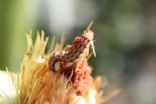(Press-News.org) FLORENCE - There are almost 275,000 acres of corn planted in South Carolina, with an economic impact of approximately $130 million. Though this is dwarfed by Midwest states such as Iowa (13.7 million acres, $8.75 billion), it's still a lot of corn - enough, at least, to make a person think S.C. would be a utopia for the insects that like to feast on tasty yellow kernels.
But instead of being a slice of paradise, a cornfield can often be a far-from-optimal host for pests such as the corn earworm. Francis Reay-Jones, an associate professor and research scientist for Clemson University, is striving to keep it that way.
"I work on insect pest management strategies and make recommendations specifically tailored for farmers in South Carolina," said Reay-Jones, an entomologist who is based at the Pee Dee Research and Education Center near Florence. "In addition to the corn earworm, another key pest of corn is the fall armyworm that arrives in our state after overwintering in the Caribbean and south Florida. They fly north throughout the U.S. every year - and when and where they show up is really difficult to predict."
Funded partially by a grant from the USDA in collaboration with N.C. State's Dominic Reisig and other colleagues, as well as a five-year Hatch project (SC01700519) titled "Ecology and Management of Arthropods in Corn," Reay-Jones is conducting ongoing research involving genetically modified corn expressing Bacillus thuringiensis (Bt) toxins. Produced by the plant as opposed to being applied by external means, these toxins are effective against corn borers while also suppressing or controlling corn earworms, fall armyworms and several other pests. Bt corn seed first hit the U.S. market in 1996, and several products expressing different toxins sold by large seed companies are currently used.
"We are continuing to look at how injury from these insects impacts the yield of Bt hybrids," said Reay-Jones, who also conducts trials at Edisto Research and Education Center in Blackville. "Over the years, the seed companies have released hybrids with new Bt toxins or hybrids expressing multiple Bt toxins (known as pyramided Bt corn), and it's important that we continue to test them, as toxins vary in how they affect corn earworms and fall armyworms. There's a real benefit in having university scientists provide unbiased recommendations."
When it comes to nature, nothing lasts forever - keeping scientists on their toes. Reay-Jones and his collaborators across the nation are charged with keeping a close eye on changes in susceptibility to Bt toxins. When an insecticide is first used, a small proportion of the insect population might survive exposure because of a particular genetic makeup. With repeated use of an insecticide, selection pressure can lead to an increase in the population of resistant insects. What this means to corn growers is that there is always a risk that the proportion of the ravenous pests that has already developed resistance to the Bt toxins will grow from relatively small to catastrophically large.
A recent study published by Reisig and Reay-Jones showed that Bt corn expressing Cry1Ab toxin had less of an effect on corn earworm now than it did in the late 1990s, suggesting that changes are happening in the field in regards to how susceptible corn earworm is to this Bt toxin.
"Although Bt corn expressing Cry1Ab was developed to control the European corn borer, it also provides some control of corn earworm feeding on corn ears," Reay-Jones said. "Some laboratory data and our recent study suggest that there have been changes in susceptibility of corn earworm to this toxin in some parts of the country."
As a direct follow-up to this work, N.C. State, Clemson and Mississippi State have been funded by the USDA grant to look at the ecology of corn earworm on corn, soybean and cotton - three major crops that suffer from damage by corn earworm. The corn component of the grant is examining the impact of Bt traits on survival and fecundity of corn earworm.
"We collect corn ears - when we know we have big larvae that are about to pupate - and put them in plastic boxes with soil, and then the larvae fall to the soil to pupate and we sift them out," Reay-Jones said. "We can't do that in the field. It's too complicated and takes too much time. And so it's a rather simple way to get some nice data from these Bt and non-Bt hybrids. We then use the data to look at how these traits impact the production of pupae and fecundity of moths."
Though detrimental to corn earworms, the toxins produced by Bt corn hybrids are harmless to humans. The plant expresses the toxin through its leaves, silk and kernels.
"Eggs are laid on corn silks, and young larvae quickly enter the ear, which makes them particularly difficult to control with applications of insecticide," Reay-Jones said. "So having the plant express the insecticide can be an effective way of controlling the pest, depending on which Bt corn trait is planted. Growers that plant Bt corn are also required to plant a portion of their total corn acreage with a non-Bt corn hybrid as part of an insecticide resistance management strategy to help delay the development of resistance. The efficacy of Bt corn needs to be sustained by complying with these mandated refuge requirements. On-going studies aim to detect resistance before field failures occur, as well as provide information on pest biology that will help to improve resistance management strategies."
INFORMATION:
A new study from The University of Texas Health Science Center at San Antonio found that mothers with chemical intolerances are two to three times more likely than other women to have a child with autism spectrum disorder (ASD) or attention deficit hyperactivity disorder (ADHD).
The medical study was published in the July-August 2015 issue of the Journal of the American Board of Family Medicine.
People who are chemically intolerant often have serious reactions to common chemicals and some become too sick to carry out routine functions. Chemical intolerance affects about ...
New research reveals that the more people think they know about a topic in general, the more likely they are to allege knowledge of completely made-up information and false facts, a phenomenon known as "overclaiming." The findings are published in Psychological Science, a journal of the Association for Psychological Science.
"Our work suggests that the seemingly straightforward task of judging one's knowledge may not be so simple, particularly for individuals who believe they have a relatively high level of knowledge to begin with," says psychological scientist Stav Atir ...
(New York, July 18, 2015) Researchers from the NYU Langone Medical Center, NYU School of Medicine will present new findings at the 2015 Alzheimer's Association International Conference in Washington, D.C., July 18-23-2015.
The NYU Langone Alzheimer's Disease Center is comprised of the Center for Cognitive Neurology, Center for Brain Health and the Parkinson's and Movement Disorders Center.
It is one of thirty Alzheimer's disease research centers in the United States supported by the National Institute on Aging (NIA). As an NIA-supported research facility, the center's ...
HER2 membrane proteins play a special role in certain types of breast cancer: amplified levels of HER2 drive unrestricted cell growth. HER2-tailored antibody-based therapeutics aim to prevent cancer cell growth. However, two-thirds of HER2 positive breast cancer patients develop resistance against HER2-targeting drugs. The reason for this is not yet understood. Researchers now found out, that HER2 dimers appeared to be absent from a small sub-population of resting SKBR3 breast cancer cells. This small subpopulation may have self-renewing properties that are resistant to ...
SAN ANTONIO (July 17, 2015) -- Researchers from the School of Medicine at The University of Texas Health Science Center at San Antonio have found evidence that directly links disrupted metabolism (energy production in cells) to a common and often fatal type of lymphoma. The finding was announced Thursday (July 16) in Nature Communications.
"The link between metabolism and cancer has been proposed or inferred to exist for a long time, but what is more scarce is evidence for a direct connection -- genetic mutations in metabolic enzymes," said senior author Ricardo C.T. ...
Lower levels of cholesterol in certain immune cells--a result of enhanced cholesterol metabolism within those cells--may help explain why some HIV-infected people are able to naturally control disease progression, according to research that will be presented in a poster at the 8th International AIDS Society Conference on HIV Pathogenesis, Treatment and Prevention (IAS 2015) in Vancouver, Canada, and the pre-conference 2015 Towards an HIV Cure Symposium. The findings provide a basis for potential development of new approaches to control HIV infection by regulating cellular ...
Washington, DC - July 17, 2015 - The success of probiotics for boosting human health may depend partly upon the food, beverage, or other material carrying the probiotics, according to research published on July 10th in Applied and Environmental Microbiology, a journal of the American Society for Microbiology.
"Our findings indicate that the manner in which a probiotic is delivered--whether in food or supplement form--could influence how effective that probiotic is in delivering the desired health benefits," said corresponding author Maria Marco, PhD, an associate professor ...
When a power company wants to build a new wind farm, it generally hires a consultant to make wind speed measurements at the proposed site for eight to 12 months. Those measurements are correlated with historical data and used to assess the site's power-generation capacity.
At the International Joint Conference on Artificial Intelligence later this month, MIT researchers will present a new statistical technique that yields better wind-speed predictions than existing techniques do -- even when it uses only three months' worth of data. That could save power companies time ...
Researchers at Harvard University and the University of California, San Diego, have developed a new user-friendly resource to accompany the powerful gene editing tool called CRISPR/Cas9, which has been widely adopted to make precise, targeted changes in DNA. This breakthrough has the potential to facilitate new discoveries in gene therapies and basic genetics research. The research was published in the July 13 issue of Nature Methods.
The study describes an approach to simplify a laborious part of the gene editing process using the CRISPR/Cas9 system: choosing the best ...
ROSEMONT, IL - Teaching coaches about injury prevention and contact restrictions pays off, say researchers who tracked injury rates among youth football players during the 2014 season.
"With an estimated three million youth aged 7 to 14 years old playing tackle football each year, preventing injuries is key. Our study showed that kids who received a comprehensive education from a coach had fewer injuries," said lead author Zachary Y. Kerr, PhD, MPH of the Datalys Center for Injury Research and Prevention.
Kerr and his team had athletic trainers evaluate and track ...

